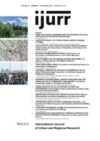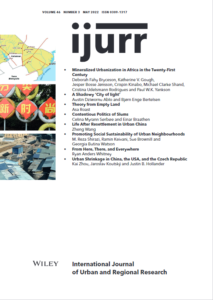Volume 46 Issue 3 May 2022
In This Issue...
In the May 2022 issue of IJURR, we have the opportunity to read eight exciting new research articles that address urban injustice across the world, especially in Angola, Ghana, Brazil, China, the Czech Republic, Mexico, Tanzania, and the United Kingdom.
The issue kicks off with two ground-breaking articles on urban realities in Africa. In the co-authored paper led by Deborah Fahy Bryceson, we witness the impact of extractive mining industries on the living conditions of mining settlements, particularly concerning housing and urban services in Angola, Ghana and Tanzania. Using a rich, multi-sited survey to obtain a comparative, cross-sectional picture of site conditions, the authors deploy the concept of ‘mineralized urbanization’ and provide a vivid picture of the catalytic role of the mining industry in shaping urbanization at the frontiers of extractive and extended urbanization in Africa.
In their research on the private urbanism driving land acquisition and dispossession in Ghana, Austin Dziwornu Ablo and Bjørn Enge Bertelsen focus on the pursuit of large-scale land acquisition to create what is marketed as a self-sustaining, master-planned city of Appolonia, catering to the housing needs of a rapidly growing middle class. Through their investigation into this private urban development project––dubbed the ‘City of Light’––the authors emphasize the importance of relational approaches to studying urban enclaves, that is, the need for critically examining the cascading effects of privatized urbanism on surrounding areas to identify the dispossessing impact of such development.
The article by Ryan Anders Whitney may provide readers with an insight into how such master planning may be exposed to the substantial influence of ‘best practices’ endorsed and disseminated through English-language media outlets of the global North. The article draws on the author’s work on an urban laboratory in Mexico City to argue that the preponderance of such media channels and referencing practices creates constraints on theorizing urban planning from the global South and continues to render the global North as ‘the de facto gatekeeper of the urbanism agenda’. Such an argument also calls for careful reflection on English-language based academic practices.
Also in this May issue, two articles discuss China’s experience in urban accumulation of capital, calling the efficacy of ‘authoritarian urbanism’ into question. Working with the concept of kongdi, a Chinese word that can be translated as ‘empty land’, Asa Roast observes the longer-term changes on the edge of Chongqing, and reveals the ambiguities and informal practices by users of undeveloped land that defy top-down planning and land use control. In doing so, Roast asks readers to question the meaning of the urban.
Zheng Wang’s article on ‘state-led community building’ in China leads us to think critically about the role of the Chinese state and its post-displacement strategies to build new resettlement communities. He argues that such communities experience state-led community building through a process of reterritorialization, making them (especially retired urban residents) more governable in the eyes of the state (though less so in the case of rural and working migrant residents), thereby ensuring the social stability that the Party State much desires.
The article by Celina Myrann Sørbøe and Einar Braathen focuses on the contentious politics of slums in Rio de Janeiro. They produce a lucid account of how resistance against mass favela evictions gets organized in three case-study communities, and what challenges they had to face in the course of political mobilization. Both authors also advocate a relational approach to understanding community struggles, calling for the need for an approach that is both ‘from above’ and ‘from below’, focusing attention on the dynamic entwining of the contention between the state and social movements.
Two remaining articles address the question of urban sustainability. Through a case study of Bethnal Green in London, the article by M. Reza Shirazi, Ramin Keivani, Sue Brownhill and Georgia Butina Watson brings our attention to the concept of social sustainability and introduces a tripartite framework that considers ‘neighborhoods’, ‘neighboring’, and ‘neighbors’. The paper by Kai Zhou, Jaroslav Koutsky, and Justin B. Hollander is a comparative study of China, the USA, and the Czech Republic, which compares the experience of urban shrinkage across geographies. Through the case study of three cities that exhibit insufficient responses to shrinkage problems, they call for the need for multi-level governance to tackle the detrimental impact of shrinking cities.
Put together, the authors in this issue collectively assist us in reflecting upon social injustice resulting from diverse processes of urbanization across the global North and South (and East). The original research reported in this issue had been largely carried out pre-pandemic. Given the dialectics of mobility and immobility on the one hand, and on the other suspension and flow of discourses, policies, investment and migration during the pandemic, it would be interesting for us to find out how such pre-pandemic social injustice addressed by the contributing authors mutates (post-)pandemic.
— Hyun Bang Shin
Articles
Mineralized Urbanization in Africa in the Twenty-First Century: Becoming Urban through Mining Extraction
Published online on Jun 27th, 2022 | DOI: 10.1111/1468-2427.13086 (p 342-369)
A Shadowy ‘City of Light’: Private Urbanism, Large-Scale Land Acquisition and Dispossession in Ghana
Published online on May 5th, 2022 | DOI: 10.1111/1468-2427.13085 (p 370-386)
Theory From Empty Land: Informal Commoning Outside/Within Economies and Ecologies of the Urban
Published online on May 25th, 2022 | DOI: 10.1111/1468-2427.13097 (p 387-404)
Contentious Politics of Slums: Understanding Different Outcomes of Community Resistance against Evictions in Rio de Janeiro
Published online on Apr 21st, 2022 | DOI: 10.1111/1468-2427.13082 (p 405-423)
Life After Resettlement in Urban China: State-led Community Building as a Reterritorialization Strategy
Published online on Feb 16th, 2022 | DOI: 10.1111/1468-2427.13078 (p 424-440)
Promoting Social Sustainability of Urban Neighbourhoods: The Case of Bethnal Green, London
Published online on Oct 13th, 2020 | DOI: 10.1111/1468-2427.12946 (p 441-465)
From Here, There, and Everywhere: English-language Media Outlets and Urban Planning Best Practices in the Global South
Published online on May 10th, 2022 | DOI: 10.1111/1468-2427.13098 (p 466-479)
Urban Shrinkage in China, the USA and the Czech Republic: A Comparative Multilevel Governance Perspective
Published online on Oct 15th, 2021 | DOI: 10.1111/1468-2427.13030 (p 480-496)
Issues in this volume
January 2022
March 2022
May 2022
July 2022
November 2022
September 2022

